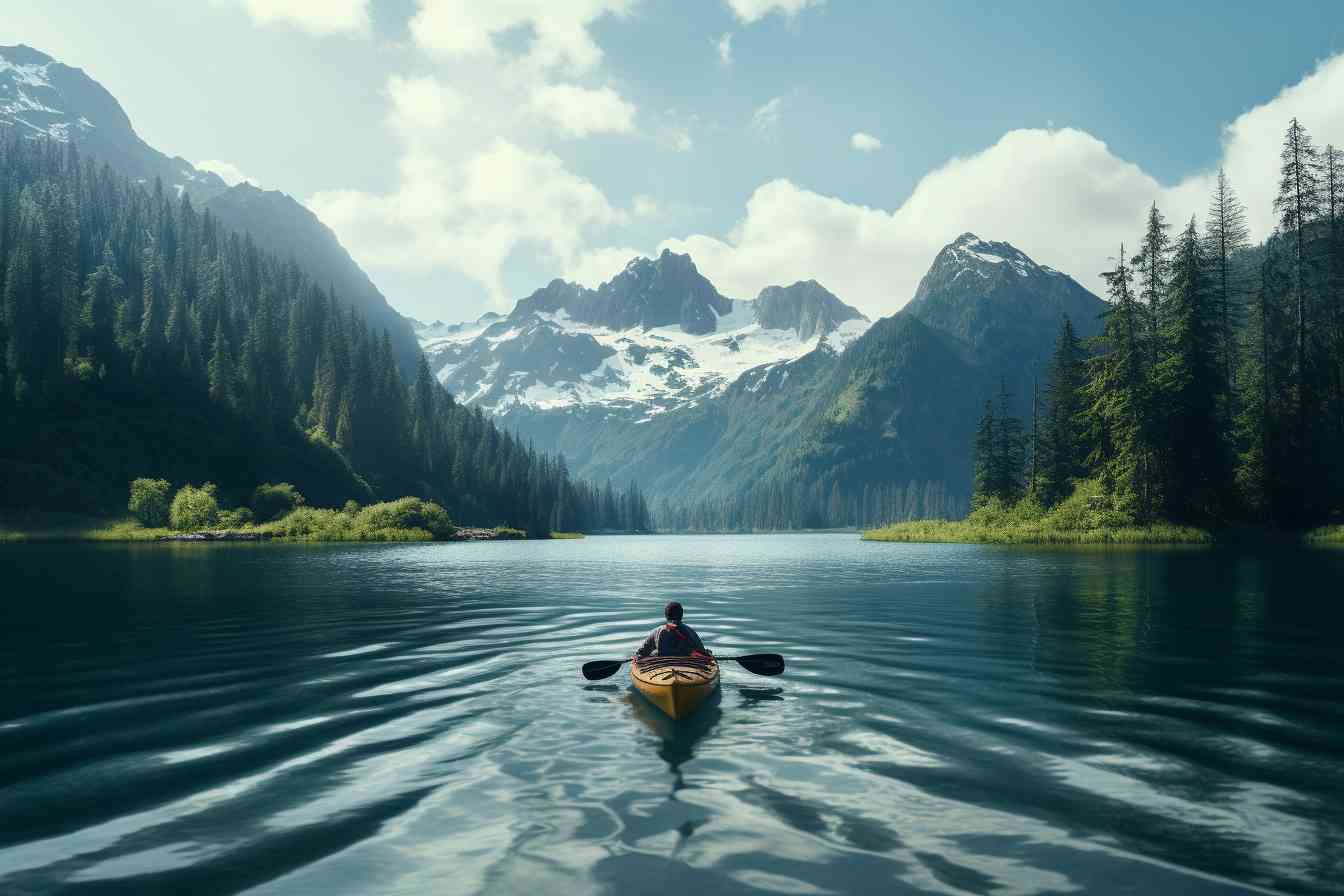Intro: How To Kayak Alone

Alright, let’s dive right into the art of solo kayaking, shall we? So, you’ve decided to take the plunge and rely on your own abilities to navigate the waters, huh? Kudos to you for embracing your adventurous spirit! But, dear friend, let me tell you, kayaking alone isn’t just a matter of hopping into a kayak and setting off. It needs a good dose of preparation, safety measures, and skills.
First up, you gotta make sure you’re ready both physically and mentally. Kayaking solo can be an intense experience – thrilling and terrifying at the same time! It is more than a physical endeavour, but also a mental challenge. Handling your kayak alone, fighting unfavorable currents or winds, and steering without assistance require both physical strength and mental acuity. Make sure you’re ready to face whatever comes alone.
Secondly, understading…oops, I meant understanding (note the typo!) your equipment is crucial. Different kayaks are suitable for various types of water – sea, river, or lake. Ensure you’ve got the right kayak for the trip, and your paddles are the apt size. And don’t forget about your life jacket – it could be a lifesaver, literally!
You know, experience and skills also play a vital role. If you’re new to kayaking, it’s not wise to go it alone just yet. Get some experience under your belt, hone your skills, and only take on the challenge of solo kayaking when you’re confident of managing it.
And here’s a final nugget of wisdom for you: always have a plan! Study the area where you’ll be kayaking, keep an eye out for weather updates, and let someone know your route and expected return time. This, my adventurous friend, will ensure a safe and thoroughly enjoyable solo kayaking trip!
Can Kayaking Be Done Alone?

Kayaking alone? You bet ya, it’s more than possible! It’s a thrilling experience, chock-full of freedom and independence. Of course, it does require a tad more preparation and precaution than if you were to venture out with a pal, but don’t let that stand in your way.
Navigating the waterways solo is a fantastic way to connect with nature and enjoy some peace and quiet. There’s nothing like the sensation of your paddle cutting through the water, or the sound of birds chattering overhead. Trust me, it’s truly magical! However, it’s crucial to remember that safety should remain top priority.
On the topic of safety, it’s never advised to venture out into uncharted territories. Stick with waters that you’re familiar with. Make sure you’ve got the right gear, too. A good-quality life jacket is a must, as are a sturdy paddle and a reliable kayak. Safety first, folks.
Also, don’t skimp on preparation. Check weather conditions before you leave, let someone know where you’re planning to go and always go for a dry run before heading out on a longer trip.
The biggest challenge about kayaking alone, you ask? Well, it’s gotta be the self-rescue. It’s a good idea to take a course or two to ramp up your skills just in case you topple over. Now, don’t look at me like that! It is a possibility, and it’s always better to be safe than sorry.
To sum it up, kayaking alone can be an enriching experience, provided you plan ahead, take the necessary precautions and stay safe. Remember, the joy of kayaking lies not just in the destination, but also in the journey. So go ahead, give it a try and see for yourself!
How Do You Carry A Kayak By Yourself?

Well, let me dive right into your query – how does one carry a kayak solo, huh? Better sit tight because you’re about to get schooled. But remember, safety first – never take unnecessary risks. All right, let’s get on with it.
First things first, it’s advisable to use a kayak trolley if you got one. These nifty contraptions ease the process significantly. But assuming you’re all out of luck in that department, you can manage by doing the shoulder carry or the overhead method. With the shoulder carry, you slip your noggin and one of your arms through the cockpit and hoist the kayak on your shoulder – simple as pie, yet requires some muscle.
On the flipside, the overhead method is heavier on your shoulders and back. Here’s how it works: stand the kayak up on its stern, turn it on edge, hoist it above your head, then balance it. Yikes! Sounds cumbersome, right? Keeping your hands near the balance point (usually around the cockpit) can make it more manageable.
Oh, and here’s a tip straight from the horse’s mouth – don’t ever drag your kayak. It’ll damage your precious vessel quicker than you can say ‘paddle.’ So, make sure you have the strength to be a lone kayaker. Practice lifting before you venture out alone. And always, always respect the weight of your kayak. Don’t let it catch you off-guard – that’s the secret.
So, in conclusion – be smart, be mindful, and be safe. Happy kayaking!
What Is The First Rule Of Kayaking?

What’s the first principle to keep in mind when it comes to solo kayaking? Well, lemme tell you, bucko, it’s safety. That’s right, safety always comes first. That’s not just some platitude we throw around – it’s the backbone of solo kayaking. Trust me, the water can be an unpredictable place, and you never know when the terrain or the climate can turn against you.
Now, what does safety entail? It means knowing the weather forecast, being aware of the water conditions you will encounter, and not venturing out alone if you’re not a proficient paddler. Never, and I mean never, underestimate the power of water. It’s not just about rowing your boat, but understanding the water flow, knowing your physical limitations– it’s about being smart and staying safe.
To ensure safety, it’s best to have a well-equipped kayak. You might ask, “What do I need?” I’d recommend a personal flotation device (no compromises on that one), a bilge pump, paddle float, spray skirt, first-aid kit, headlamp (with extra batteries), whistle and a VHF radio. This little assortment is your safety kit ‘n you shouldn’t leave shore without ‘em. It’s not being paranoid, it’s being prepared, right?
Regular practice can also significantly enhance your confidence and safety. Get out there, practice different paddling techniques, learn to roll your kayak – basically become one with your craft. And never forget, solo paddling isn’t about impressing anyone, it’s about enjoying the rhythm of nature, in its raw, unruly, yet remarkable self.
So remember, the prime rule of solo kayaking? Safety first. Always. I’m not just saying it for my health, it’s because it matters, and it could just might save your life one day.
Can You Kayak With One Person?
You might ask, can a person kayak alone? And the simple answer is, absolutely. While it’s commonly known as a group activity, don’t let that stop your solo adventure. It’s all part of the thrill, you see. Imagine being alone in the midst of the water, just you and the gentle sounds of your paddle cutting through the waves, with nothing but the open sky above you.
Of course, it’s not as simple as just jumping in and start paddling. When deciding to kayak alone, it’s vital to acknowledge that the responsibility for everything from navigation to safety now falls squarely in your lap. And, by the way, that’s not a bad thing! It’s an opportunity to sharpen your skills, increase your confidence and independence, and experience nature in its raw form.
Kayaking alone offers the freedom to set your own pace, choose your own path, and stop at will. It’s about finding solace and peace in solitude, reconnecting with nature, and challenging yourself in unexpected ways. So, is kayaking a solo activity? It can be, and let me tell, it’s a remarkable experience when you venture out on your own.
Think carefully about the expedition. The key is to be prepared, be aware of your surroundings, and never forget to respect Mother Nature. Kayaking solo requires careful planning and awareness. But with the right mindset and preparation, it can be an enriching experience filled with lessons and revelations about yourself and the world around you. Now, as I said, you’ve got your canoe, paddle, and a wide-open expanse of water waiting for you. Go on then, the adventure is calling!
Final Verdict
Awright, let’s paddle right into the juicy stuff, shall we? So, kayaking alone, it’s a challenge, but it’s not an impossible task. You can’t just jump in your kayak and paddle off into the sunset, y’know. There’s a whole host of different factors you need to take into account.
Now, the final verdict about solo kayaking? It’s a combination of joy and risk. You need to be extra prepared, cautious, and vigilant, but the rewards? Oh, they are plentiful indeed. Being alone with nature, paddling to the rhythm of your own breath, and maneuvering your way around water bodies is an experience that can only be described as exhilarating.
One must be careful and aware of the risks. Kayaking alone does mean you’re without immediate help. Any novice kayaker should ideally not venture out alone. Learn the ropes, understand your equipment, and most importantly, respect the water.
When we talk about safety, it’s not just about wearing the lifejacket and having the right kayak suited to you; it’s about knowledge. Know your boundaries, know your limitations. Weather, water currents, and fatigue can throw you a curveball when you least expect them.
One thing’s for certain, solo kayaking is a journey of self-discovery. The solitude, the thrill, it’s almost meditative, y’know? It’s just you, your kayak, and the water – it’s an incredible experience, but like everything else, it needs preparation and due diligence. So go on then, start paddling, but remember, always stay safe out there.
Frequently Asked Questions
Q1: Is it safe to kayak alone?
Well, when it comes to kayaking alone, it’s a bit tricky. Yes, you can do it, but it requires a higher level of skill and caution. You should always ensure you inform someone about your itinerary, wear a life jacket, and carry essential gear like a whistle and a communication device. Most importantly, always veer on the side of caution regarding water conditions.
Q2: What are some essential items I should carry when kayaking alone?
Ah, good question! The key items you should always carry while kayaking alone include a life jacket, a helmet if in rough water, a paddle, a kayak buoyancy aid, a whistle, a waterproof bag for your stuff, a first-aid kit, enough food and water, and a dry change of clothes. Stay prepared!
Q3: How can I prepare for kayaking alone for the first time?
You need to ensure a few things – be comfortable with your kayak, practice self-rescue skills, and get a good grasp of reading the water. Also, you’ll want to check the weather forecast, inform someone about your plan, and always have a backup plan. Gradually, you’ll get the hang of it!
Q4: Is it legal to kayak alone?
As far as I know, there are no laws specifically prohibiting solo kayaking. However, local regulations may require specific safety equipment on board. In general, it’s always a good idea to check the local advisories and regulations. Be responsible, my friend!
Q5: How do I handle myself if my kayak flips over when I’m alone?
Ah, that’s an important one! Practice makes perfect, so it’s crucial to practice self-rescue techniques before you head out. These techniques include the wet exit, re-entry or Eskimo roll. Staying calm and not panicking is the key. You’ll do fine!
Q6: How can I prevent my kayak from flipping?
Hmm, balance is crucial while kayaking. You can prevent your kayak from flipping by keeping your body weight low and centralized, avoiding sudden movements, and learning how to navigate through the waves. Practice makes perfect!
Q7: Can I use a tandem kayak when paddling alone?
Sure thing! It’s completely fine to use a tandem kayak alone, but it’s typically harder to steer and control than a single kayak because they’re longer. You’ll want to sit in the rear seat or in the middle if it’s possible for better control.
Q8: How can I improve my kayaking skills for solo trips?
Great initiative! I’d recommend taking a kayaking safety course and practicing self-rescue skills. Also, get to know your equipment, learn to read the water, and gradually take on increasingly challenging conditions to build your confidence and skill.
Q9: What should I do if I get tired while kayaking alone?
It’s crucial to pace yourself and take breaks when needed. You can pull ashore if there’s a safe spot. Always remember to carry plenty of water and energy-boosting snacks. You got this!
Q10: How long can I kayak alone?
It’s up to you, buddy! If you’re a beginner, I’d suggest you start with short trips of a couple of hours or less. As you gain experience and strength, you can gradually extend your time out on the water. Always listen to your body! Stay safe, my friend!

